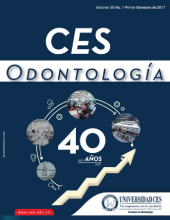Difference in hardness of composites polimerized with differnt types of lights
DOI:
https://doi.org/10.21615/cesodon.30.1.1Keywords:
Filtek Supreme XT, Z350, Tetric Ceram N, Esthet X, curing, VickersAbstract
Introduction and objective: When using direct composites is important totake into account the specific characteristics of the material and the instrumentslike the curing lamp used to built any kind of restoration withcomposite. Create scientific evidence so professionals can choose the typeof lamp, composite, and the needed technique to provide a better clinical result. Materials and methods: 10 samples were made in 24 groups, which evaluated3 types of lamps: (Optilux® 501 - halogen at full power), (Optilux® 501 - halogenramp) and (Bluephase® - LED), with 4 types of resins: Filtek® Supreme XT, Filtek®Z350, Tetric® N Ceram and Esthet ®X, and 2 placement techniques: incremental andblock. The Vickers hardness by penetration at the surface and deep of each samplewas evaluated. The results were analyzed both bi-and multivariate. Results: Filtek®Supreme XT showed the highest hardness, followed by Filtek® Z350, Tetric® N Ceramand Esthet® X. The hardness was dependent on the lamp; the values were higherwith Optilux® 501 with ramp, followed by Optilux® 501 at full power and finally LEDBluephase®. Better results were obtained using the technique of incremental placementcompared with the block one, and these were higher in the surface regioncompared to deep region. Conclusion: The highest hardness was obtained with resinFiltek® Supreme XT, using the lamp Optilux® 501 with ramp and positioned with anincremental technique.
Downloads
References
Guzmán H. Resinas compuestas. Biomater Odontológicos uso clínico. 2006;Cuarta ed(Bogotá: Ecoe):175–208. http://scielo.isciii.es/scielo.php?script=sci_arttext&pid=S1698-69462006000200023
Feilzer AJ, De Gee AJ, Davidson CL. Setting stress in composite resin in relation to configuration of the restoration. J Dent Res. 1987;66(11):1636–1639. https://www.ncbi.nlm.nih.gov/pubmed/10872397
Ilie N, Hickel R. Can CQ be completely replaced by alternative initiators in dental adhesives? Dent Mater J. 2008;27(2):221–228. https://www.ncbi.nlm.nih.gov/pubmed/18540396
Phillips. Ciencia de los materiales dentales. Anusavice Elsevier. 2004. p. 34. https://books.google.com.co/books/about/Phillips_ciencia_de_los_materiales_denta.html?id=4UnIFbmAUqEC&redir_esc=y
Tiba A, Zeller GG, Estrich CG, Hong A. A laboratory evaluation of bulk-fill versus traditional multi-increment-fill resin-based composites. J Am Dent Assoc. 2013;144(10):1182–1183. https://www.ncbi.nlm.nih.gov/pubmed/25946430
Manhart J, García-Godoy F, Hickel R. Direct posterior restorations: clinical results and new developments. Dent Clin North Am. 2002;46(2):303–339. http://www.dental.theclinics.com/article/S0011-8532(01)00010-6/abstract
de Araújo CS, Schein MT, Zanchi CH, Rodrigues SA, Demarco FF. Composite resin microhardness: the influence of light curing method, composite shade, and depth of cure. J Contemp Dent Pract. 2008;9(4):43–50. https://www.ncbi.nlm.nih.gov/pubmed/18473026
Giachetti L, Scaminaci Russo D, Bambi C, Grandini R. A review of polymerization shrinkage stress: current techniques for posterior direct resin restorations. J Contemp Dent Pract. 2006;7(4):79–88. https://www.ncbi.nlm.nih.gov/pubmed/16957794
Carvalho RM, Pereira JC, Yoshiyama M, Pashley DH. A review of polymerization contraction: the influence of stress development versus stress relief. Oper Dent. 1996;21(1):17–24. https://www.ncbi.nlm.nih.gov/pubmed/8957911
Leprince JG, Palin WM, Hadis MA, Devaux J, Leloup G. Progress in dimethacrylate-based dental composite technology and curing efficiency. Dent Mater. 2013;29(2):139–156. https://www.ncbi.nlm.nih.gov/pubmed/23199807
Ling L, Xu X, Choi G-Y, Billodeaux D, Guo G, Diwan RM. Novel F-releasing composite with improved mechanical properties. J Dent Res. 2009;88(1):83–88. https://www.ncbi.nlm.nih.gov/pubmed/19131323
Yap AUJ, Saw TY, Cao T, Ng MML. Composite cure and pulp-cell cytotoxicity associated with LED curing lights. Oper Dent. 2004;29(1):92–99. http://europepmc.org/abstract/med/14753339
Ruiz, J. M., Ceballos, L., Fuentes, M. V., Osorio, R., Toledano, M., & García-Godoy F. Propiedades mecánicas de resinas compuestas modificadas o no con poliácidos. Av Odontoestomatol. 2003;9(6):291–297. http://scielo.isciii.es/scielo.php?script=sci_abstract&pid=S0213-12852003000600005
Guzmán H. Unidades de fotocurado. Soc Colomb Oper Dent y Biomater. 2000;Vol 4(Bogotá):227–241.
Laboratorios Farpag Ltda. Salivar. 2009. http://www.farpag.com/index.php?option=com_content&view=article&id=107&Itemid=548
Ilie N, Hickel R. Macro-, micro- and nano-mechanical investigations on silorane and methacrylate-based composites. Dent Mater. 2009;25(6):810–819. https://www.ncbi.nlm.nih.gov/pubmed/19286247
Zupancic R, Legat A, Funduk N. Tensile strength and corrosion resistance of brazed and laser-welded cobalt-chromium alloy joints. J Prosthet Dent. 2006;96(4):273–282. https://www.ncbi.nlm.nih.gov/pubmed/17052472
Watanabe T, Miyazaki M, Moore BK. Influence of polishing instruments on the surface texture of resin composites. Quintessence Int. 2006;37(1):61–67. https://www.ncbi.nlm.nih.gov/pubmed/16429705
Tanoue N, Koishi Y, Matsumura H, Atsuta M. Curing depth of different shades of a photo-activated prosthetic composite material. J Oral Rehabil. 2001;28(7):618–623. https://www.ncbi.nlm.nih.gov/pubmed/11422692
Rode KM, Kawano Y, Turbino ML. Evaluation of curing light distance on resin composite microhardness and polymerization. Oper Dent. 2007;32(6):571–578. https://www.ncbi.nlm.nih.gov/pubmed/18051007
Catelan A, de Araújo LSN, da Silveira BCM, Kawano Y, Ambrosano GMB, Marchi GM, et al. Impact of the distance of light curing on the degree of conversion and microhardness of a composite resin. Acta Odontol Scand. 2015;73(4):298–301. https://www.ncbi.nlm.nih.gov/pubmed/25639534
Catelan A, Mainardi M do CAJ, Soares GP, de Lima AF, Ambrosano GMB, Lima DANL, et al. Effect of light curing protocol on degree of conversion of composites. Acta Odontol Scand. 2014;72(8):898–902. https://www.ncbi.nlm.nih.gov/pubmed/24856190
Jafarzadeh T-S, Erfan M, Behroozibakhsh M, Fatemi M, Masaeli R, Rezaei Y, et al. Evaluation of Polymerization Efficacy in Composite Resins via FT-IR Spectroscopy and Vickers Microhardness Test. J Dent Res Dent Clin Dent Prospects. 2015;9(4):226–232. https://www.ncbi.nlm.nih.gov/pubmed/26889359
Ferracane JL, Aday P, Matsumoto H, Marker VA. Relationship between shade and depth of cure for light-activated dental composite resins. Dent Mater. 1986;2(2):80–84. https://www.ncbi.nlm.nih.gov/pubmed/3458636
Chapter 13; Composites R – Resin-Based Composites. Phillips’ Sci Dent Mater. 2013;275–306. https://pocketdentistry.com/resin-based-composites-2/
Cramer NB, Stansbury JW, Bowman CN. Recent advances and developments in composite dental restorative materials. J Dent Res. 2011;90(4):402–416. https://www.ncbi.nlm.nih.gov/pmc/articles/PMC3144137/
Min S-H, Ferracane J, Lee I-B. Effect of shrinkage strain, modulus, and instrument compliance on polymerization shrinkage stress of light-cured composites during the initial curing stage. Dent Mater. 2010;26(10):1024–1033. https://www.ncbi.nlm.nih.gov/pubmed/20684977
Masouras K, Silikas N, Watts DC. Correlation of filler content and elastic properties of resin-composites. Dent Mater. 2008;24(7):932–939. https://www.ncbi.nlm.nih.gov/pubmed/18155132
Leprince J, Palin WM, Mullier T, Devaux J, Vreven J, Leloup G. Investigating filler morphology and mechanical properties of new low-shrinkage resin composite types. J Oral Rehabil. 2010;37(5):364–376. https://www.ncbi.nlm.nih.gov/pubmed/
Berger SB, Palialol ARM, Cavalli V, Giannini M. Characterization of water sorption, solubility and filler particles of light-cured composite resins. Braz Dent J. 2009;20(4):314–318. https://www.ncbi.nlm.nih.gov/pubmed/20069255
Sabatini C. Comparative study of surface microhardness of methacrylate-based composite resins polymerized with light-emitting diodes and halogen. Eur J Dent. 2013;7(3):327–335. https://www.ncbi.nlm.nih.gov/pmc/articles/PMC4053622/
E. M. Grado de conversión de los composites: Qué es, qué importancia tiene y qué factores influyen en él.. 2002;(Accessed diciembre/9, 2008.).
Suh BI, Wang Y. Determining the direction of shrinkage in dental composites by changes in surface contour for different bonding configurations. Am J Dent. 2001;14(2):109–113. https://www.ncbi.nlm.nih.gov/pubmed/11507797
Cadenaro M, Biasotto M, Scuor N, Breschi L, Davidson CL, Di Lenarda R. Assessment of polymerization contraction stress of three composite resins. Dent Mater. 2008;24(5):681–685. http://www.sciencedirect.com/science/article/pii/S0109564107001832
Nakfoor B, Yaman P, Dennison J, Herrero A. Effect of a light-emitting diode on composite polymerization shrinkage and hardness. J Esthet Restor Dent. 2005;17(2):110–116; discussion 117. https://www.ncbi.nlm.nih.gov/pubmed/16036127
Yoon T-H, Lee Y-K, Lim B-S, Kim C-W. Degree of polymerization of resin composites by different light sources. J Oral Rehabil. 2002;29(12):1165–1173. https://www.ncbi.nlm.nih.gov/pubmed/12472853
Mills RW, Jandt KD, Ashworth SH. Dental composite depth of cure with halogen and blue light emitting diode technology. Br Dent J. 1999;186(8):388–931. https://www.ncbi.nlm.nih.gov/pubmed/10365460
Stahl F, Ashworth SH, Jandt KD, Mills RW. Light-emitting diode (LED) polymerisation of dental composites: flexural properties and polymerisation potential. Biomaterials. 2000;21(13):1379–1385. https://www.ncbi.nlm.nih.gov/pubmed/10850932
Uhl A, Mills RW, Vowles RW, Jandt KD. Knoop hardness depth profiles and compressive strength of selected dental composites polymerized with halogen and LED light curing technologies. J Biomed Mater Res. 2002;63(6):729–738. http://onlinelibrary.wiley.com/doi/10.1002/jbm.10390/abstract
Shortall AC, Harrington E. Temperature rise during polymerization of light-activated resin composites. J Oral Rehabil. 1998;25(12):908–913. https://www.ncbi.nlm.nih.gov/pubmed/9888225
Dunn WJ, Taloumis LJ. Polymerization of orthodontic resin cement with light-emitting diode curing units. Am J Orthod Dentofacial Orthop. 2002;122(3):236–241. https://www.ncbi.nlm.nih.gov/pubmed/12226603
St-Georges AJ, Swift EJ, Thompson JY, Heymann HO. Curing light intensity effects on wear resistance of two resin composites. Oper Dent. 27(4):410–417. https://www.ncbi.nlm.nih.gov/pubmed/12120780
Kurachi C, Tuboy AM, Magalhães D V, Bagnato VS. Hardness evaluation of a dental composite polymerized with experimental LED-based devices. Dent Mater. 2001;17(4):309–315. https://www.ncbi.nlm.nih.gov/pubmed/11356207
Leonard DL, Charlton DG, Roberts HW, Cohen ME. Polymerization efficiency of LED curing lights. J Esthet Restor Dent [Internet]. 2002;14(5):286–295. https://www.ncbi.nlm.nih.gov/pubmed/12405584
Vandewalle KS, Roberts HW, Miniotis N. Critical appraisal. Quartz-tungsten-halogen and light-emitting diode curing lights. J Esthet Restor Dent. 2006;18(3):161–167. https://www.ncbi.nlm.nih.gov/labs/articles/16831190/
Halvorson RH, Erickson RL, Davidson CL. Polymerization efficiency of curing lamps: a universal energy conversion relationship predictive of conversion of resin-based composite. Oper Dent. 29(1):105–111. https://www.ncbi.nlm.nih.gov/pubmed/14753341
Sideridou I, Tserki V, Papanastasiou G. Study of water sorption, solubility and modulus of elasticity of light-cured dimethacrylate-based dental resins. Biomaterials. 2003;24(4):655–665. https://www.ncbi.nlm.nih.gov/pubmed/12437960
da Silva EM, Almeida GS, Poskus LT, Guimarães JGA. Relationship between the degree of conversion, solubility and salivary sorption of a hybrid and a nanofilled resin composite. J Appl Oral Sci. 16(2):161–166. https://www.ncbi.nlm.nih.gov/pubmed/19089210
Fu, SY, Feng, XQ, Lauke B, Mai YW. Effects of particle size, particle/matrix interface adhesion and particle loading on mechanical properties of particulate–polymer composites. Compos Part B Eng. 2008;39(6):933–961. http://www.sciencedirect.com/science/article/pii/S135983680800005X
Downloads
Published
How to Cite
Issue
Section
License
Copyright (c) 2021 CES Odontología

This work is licensed under a Creative Commons Attribution-NonCommercial-ShareAlike 4.0 International License.
| Article metrics | |
|---|---|
| Abstract views | |
| Galley vies | |
| PDF Views | |
| HTML views | |
| Other views | |



